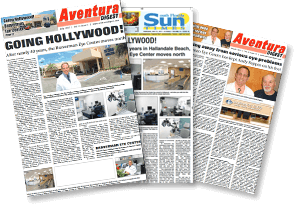LASIK – Laser Vision Correction
LASIK and alternatives to the LASIK Procedure
LASIK is purely an elective procedure, and you may decide not to have this operation at all. Among the alternatives are:
- EPI-LASIK
- Eyeglasses /Spectacles
- Contact Lenses
- Photorefractive Keratectomy (PRK)
- ADVANCED SURFACE ABLATION (ASA)
- Radial Keratotomy (RK)
- Automated Lamellar Keratoplasty (ALK)
- Orthokeratology, Hexagonal Keratotomy
- Corneal Relaxing Incisions, Intracorneal Ring Segments
- PHAKIC LENS IMPLANTS
- CLEAR and NEAR CLEAR LENSECTOMY
- WAVEFRONT-OPTIMIZED LASIK
You can discuss these options with Our Staff.
epi-LASIK
The latest innovation in correcting vision is epi-LASIK (Laser assisted epithelial keratomileusis). This procedure represents an improvement over older techniques of simple PRK. In the original form of PRK the outer layer of the cornea, the epithelium, was removed and discarded. The laser ablation was performed and the patient was left with a large abrasion. The epithelium took 4-5 days to heal. Needless to say, this left the patient uncomfortable and blurry. For these reasons LASIK has become the procedure of choice. However, there are patients who have dry eyes or corneas that are too thin to perform LASIK safely. For these patients epi-LASIK becomes a great alternative.
In epi-LASIK, the surgeon carefully removes the outer epithelial covering of the cornea using a special epithelial microkeratome, then uses the excimer laser to reshape the corneal surface. The epithelial flap is replaced and a contact lens is placed to hold the epithelium. The contact lens is removed 3-4 days later. Patients see better, faster, and with greater comfort than with simple PRK.
ADVANCED SURFACE ABLATION (ASA)
ASA is nothing more than PRK or Epi-LASIK using the newer more advanced excimer laser Wavefront-Optimized treatment. Every cornea has its own fingerprint that makes it different than any other cornea in the world. With Wavefront-Optimized treatment using the Allegretto Wave Eye-Q 1010 excimer laser, we can treat each corneal fingerprint differently. Results with ASA are usually much better than standard excimer laser treatments, giving better uncorrected vision postoperatively. Wavefront-Optimized treatments can also be done using LASIK. ASA also often uses Mitomycin-C to aid with the healing of the cornea and to prevent unwanted scarring.
PHAKIC LENS IMPLANTS
This is exciting new technology that has been used around the world for many years and has been recently been approved by the FDA for use in the United States. Eye surgeons from around the world have implanted over 100,000 since 1986. This represents 2% of the refractive surgery done worldwide during this time. Phakic lens implants are appropriate for those patients between the ages of 21 and 41 years of age who are not corneal-based refractive surgery candidates (LASIK Miami, Advanced Surface Ablation, PRK or epi-LASIK) because they have very high myopia or corneas that are too thin to do corneal refractive surgery.
CLEAR and NEAR-CLEAR LENSECTOMY
This technology has been used around the world for many years and has recently become more accepted in the United States. It is a great treatment for patients who require not only distance glasses but near glasses as well. It’s popularity in the United States has been boosted because of the FDA’s recent approval of high technology intraocular lens implants that enable patients to see both at distance and at near without glasses. Lensectomy means the removal of the eye’s natural crystalline lens that focuses the incoming and outgoing light rays. This crystalline lens is replaced with an acrylic high technology intraocular lens that can improve the unaided distance as well as the unaided near vision of the patient. FDA studies on the ReZOOM Multifocal implants have shown that over 94% of patients will not need to wear distance or computer glasses and that over 83% of patients will not need reading glasses, whereas 100% of these patients needed distance and reading glasses preoperatively. We also use these high technology implants in upgraded cataract surgery.
WAVEFRONT-OPTIMIZED LASIK using Allegretto Wave Eye-Q 1010
Wavefront-Optimized LASIK represents a tremendous advance in laser technology. Up until now, we have only been able to measure the eye as a whole, and then give one overall prescription for glasses or contact lenses for each eye. Traditional LASIK attempts to replicate the vision obtainable with the best glasses and contact lenses, treating each eye with one overall prescription. But we know that the eye is not perfectly regular and that each spot on the eye actually requires its own particular prescription. This is clearly impossible with glasses or contact lenses, because they are constantly moving in relation to the eye. However, Wavefront-Optimized treatment makes this possible. The result is vision that typically surpasses traditional LASIK, and frequently is better than the best vision with glasses or contact lenses.
Allegretto Wave Eye-Q technology features a unique approach to corneal sculpting. The normal curvature of a healthy cornea is prolate, or higher in the center. Most laser systems flatten centrally to create an oblate cornea. This oblate shape causes spherical aberration, which degrades the quality of vision, especially at night, and often produces glare or halos.
The Allegretto laser not only treats the cornea centrally, but also peripherally. The laser uses proprietary nomograms to adjust the asphericity of the cornea to perform a prolate ablation based on the anterior curvature readings. This prolate curvature, in part, accounts for the excellent quality of vision during the day and night.
Our eyes are constantly making small, rapid jumps called saccadic eye movements. These movements are beyond your control and may affect the result of your surgery. This advanced laser uses high speed, precise infrared active eye tracking with a response time of less than 8 milliseconds to neutralize these movements and assure a quality treatment
A small diameter laser beam, also known as spot size, is very important for both accuracy and smoothness. The ideal beam size is 1 millimeter or less. While beam size is critical, so is the type of laser beam that is being used. A gaussian beam allows for the smoothest corneal surface as compared to non-gaussian beams. The result is that a small beam less than 1 millimeter with a gaussian profile allows for the proper and accurate treatment of the smallest curvatures of the cornea and also allows for a smooth corneal surface.
Prior to surgery, a complete eye examination is performed, including special measurements of the thickness and curvature of the cornea. The patient then undergoes the LASIK procedure: the flap is made, the laser treatment is applied under the flap using the Allegretto Wave Eye-Q 1010 treatment laser and the flap is placed back into its original position.
Because the treatment with Wavefront-Optimized LASIK is much more customized than with glasses, contact lenses, or traditional LASIK methods, the level of vision obtained is more precise. Although results vary from patient to patient, with Wavefront-Optimized LASIK it is frequently possible to achieve 20/15 vision, which is typically better than the best vision available with glasses or contact lenses.
About The Braverman Eye Center
As a leading South Florida LASIK provider, Dr. Braverman has helped numerous laser vision correction patients achieve spectacularly clear vision. In addition to laser eye surgery, the team at Braverman Eye Center performs a multitude of other vision enhancing procedures, including cataract surgery in Ft. Lauderdale / Miami.





